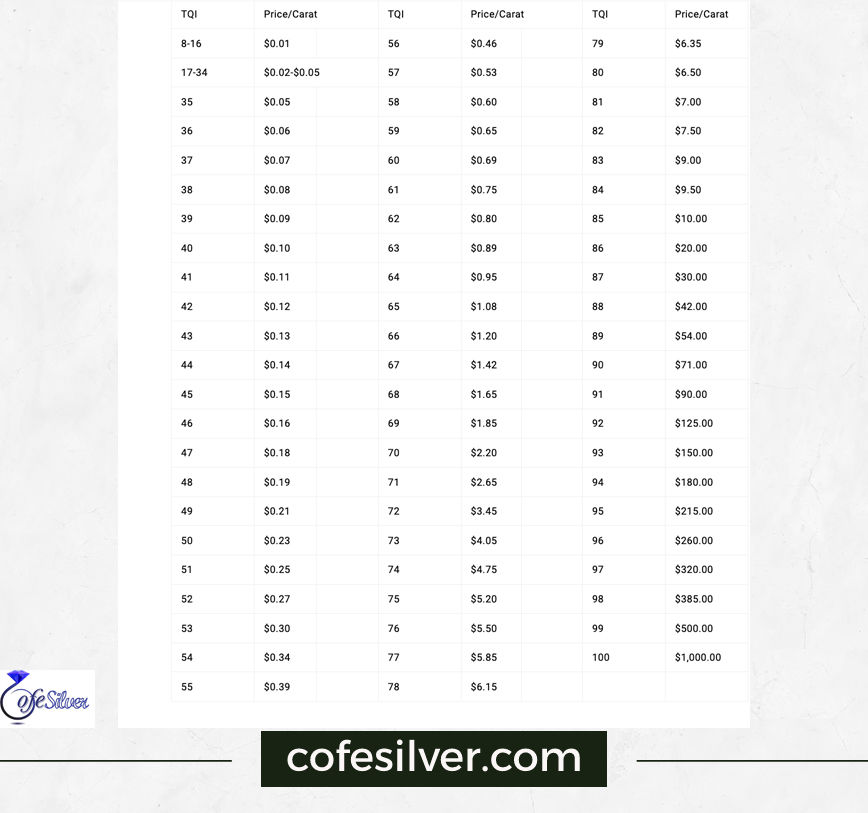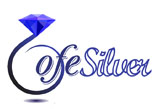Turquoise is a unique and stylish stone. Known for its beautiful blue-green color, this gemstone is one of the most popular options for modern jewelry.
Did you know that turquoise is also one of the oldest precious stones in the world? Some ancient cultures held this gem in high esteem because they considered it a sacred stone! Join us at Silver Cafe to learn more about how to buy and maintain turquoise stones.
Turquoise along with tanzanite is the birthstone of December. Whether you're born in December or you're fascinated by the facts mentioned above, turquoise jewelry is a must-have in any jewelry box. Because with proper care, this stone can be used every day!
Follow these tips to maintain its beauty for years to come.
Turquoise Ring
How to use turquoise jewelry, turquoise ring?
In terms of mineral hardness, turquoise is between 5 and 6 on the Mohs scale, which means that it is a relatively hard gemstone. You can use turquoise jewelry and rings every day as long as you take care of it.
This precious stone is subjected to processes to increase its beauty, some of these processes include stabilization, dyeing and waxing or oiling. This improves its color and durability. However, exposing turquoise to heat can cause discoloration and damage to its surface.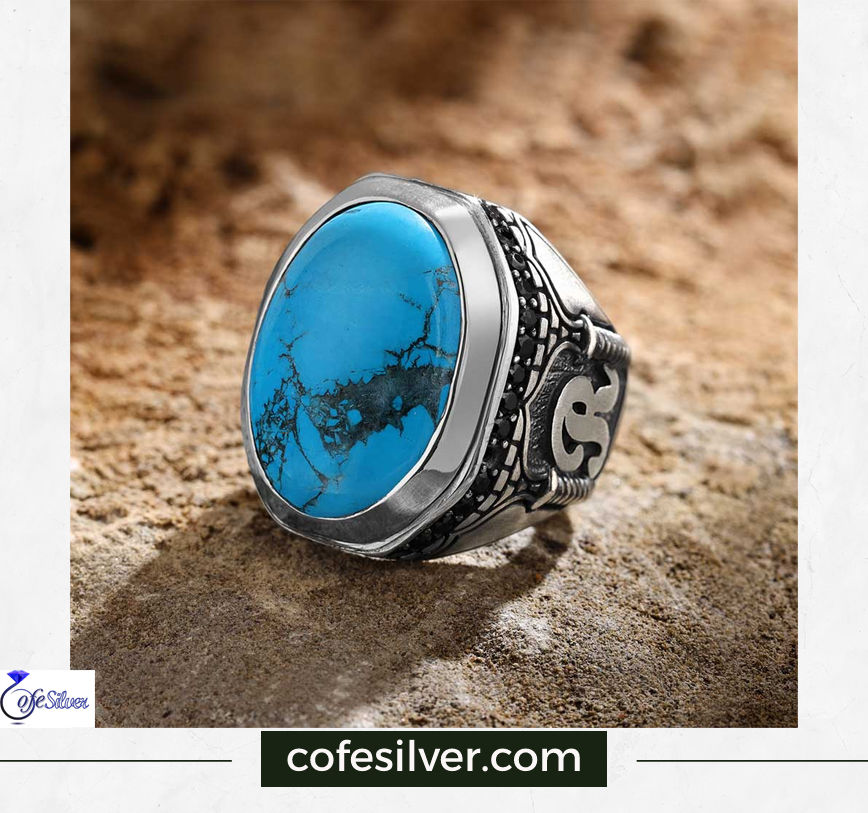
Therefore, avoid using this stone while cooking and taking a shower. It is also recommended to clean turquoise jewelry before applying cosmetics such as lotions and body oils as they can collect in the corners and make the gem appear dull.
It goes without saying that turquoise should not be worn during heavy activities such as house cleaning, gardening, sports, etc. as it is prone to damage or cracking.
How to maintain turquoise jewelry?
Store turquoise jewelry carefully in the box it comes in after each use. If you plan to store it in your jewelry box, make sure it is wrapped in a soft cloth first and that it does not come into contact with hard gemstones like diamonds, as this will cause scratches. Hard jewelry can scratch the surface, so if possible, store turquoise jewelry in a separate box. Place the box in a cool, dark place away from direct sunlight, heat or moisture. These simple tips for maintaining your turquoise jewelry will keep it fresh and beautiful for years to come.
How to clean turquoise jewelry?
Ultrasonic jewelry cleaners are not recommended for turquoise. Also, avoid using cleaners that contain chemicals to clean your jewelry, as harsh substances can damage the appearance of the gemstone. If you use it daily, clean your turquoise jewelry once a week with the following method.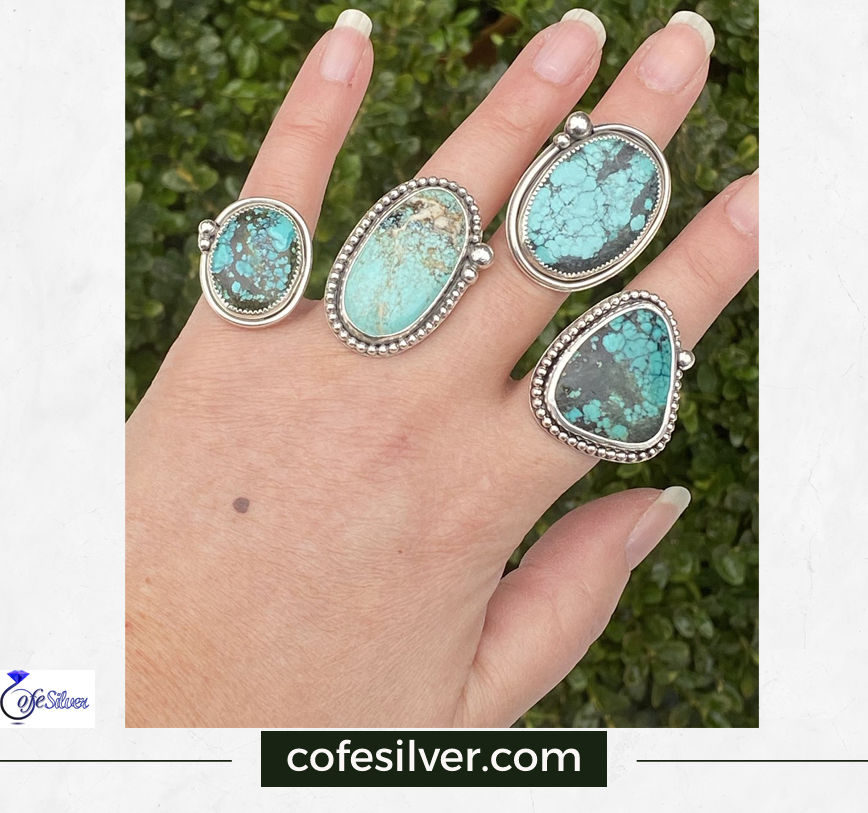
Make a soapy water solution by adding a few drops of mild detergent to a bowl of warm water.
Dip your jewelry in the solution and clean it using a soft brush. Do not soak jewelry in soapy water because turquoise is porous and absorbs liquid.
Rinse with clean water and dry the piece with a soft towel. If your jewelry and rings are silver, moisture can tarnish the metal. So, let it air dry before wearing or storing it.
The history of turquoise rings
Rings have had a mystical and symbolic meaning throughout history and in many different cultures. The circular shape represents the cycle of life and eternal love. The custom of giving rings to each other dates back to more than 6000 years ago. Giving turquoise rings as a gift seems to bring happiness and prosperity. Rings have long been a popular and prized piece of jewelry for Native Americans, who are known to have many turquoise rings on each hand.
Early indigenous rings were made of natural materials such as wood, shell, stone and bone.
Turquoise Ring
What is the price of turquoise?
First, let's mention the important things to determine the price of turquoise
Weight
Turquoise is weighed in carats, which is 5 carats equal to 1 gram. The heavier the stone, the more valuable it is. Usually, when turquoise is for sale, we see the price per carat. So the first step is to weigh the stone and then figure out how much it costs per carat. This price can vary from 0.05 to 500 dollars per carat depending on the stone.
Turquoise quality index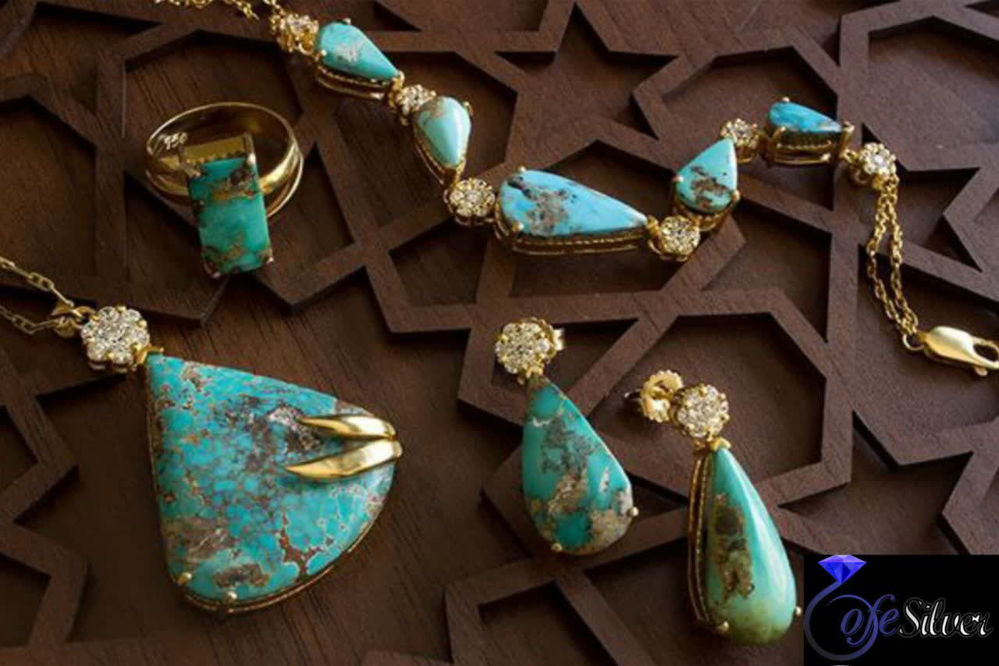
Turquoise quality index (TQI) is a measure of the quality of turquoise stone. TQI is a number on a scale between 8 and 100. The higher the TQI number, the higher the quality of the turquoise, the higher the grade and the more valuable the stone. High numbers are rare. Less than 1% of turquoise on the market has a score of 90 or better.
How to find TQI
The TQI scoring system is a great way to get a quick estimate. There are two main components that can be evaluated that contribute to the true value of turquoise. These are the physical structure of the stone and the rarity of the stone. These components are divided into 8 indicators and weighted according to their importance
Determining TQI is the process of scoring these 8 indicators. Most of these indicators are widely agreed upon. However, the color, clarity, and pattern of the stone have been the subject of controversy. It may be difficult to get an exact number due to the subjective nature of these features. Also, the availability of turquoise tends to fluctuate depending on the production levels of active mines.
This is only a guide to make it easier to evaluate the price of turquoise. There is usually a slight deviation depending on the person scoring the TQI. For more accuracy, you can consult the gemologist experts of Silver Cafe.
Turquoise is a beautiful, hard, opaque and triclinic cryptocrystalline stone found in shades of green and blue. Chemically, it is a hydrated aluminum copper phosphate. In an arid environment, turquoise forms underground within host rocks (such as limestone and sandstone) under high temperature and pressure, and hardens into glass.
The combination of different elements in the host rock material can change the appearance and structural integrity. Some turquoise is not fully formed and needs strengthening agents to be usable in jewelry. The physical properties of the obtained stone are key indicators that help determine the value of the stone.
Physical structure has 55 points: hardness (20), increase (20), composition (10) and cutting (5).
No two turquoise stones are alike. Fragments and impurities of the host stone that do not turn into turquoise create a matrix of lovely unique colors and patterns. Artificial plastic turquoise dyed blue and machine molded can be mass produced and has little value.
On the other hand, if a calcium-rich seashell fossilized near a copper vein in the arid American Southwest, it could turn turquoise. While this is extremely rare, it can only occur under the right circumstances. The rarity of this origin of turquoise, along with other rare quality indicators, brings an extraordinary value to our favorite blue stone. One of the most valuable turquoise stones is the turquoise of our country in Neishabur.
Rarity consists of 45 points: origin (20), color pattern (20) and continuous size (5).
Measurement of stone hardness
Hardness is a measurable quality that indicates how easily a material can be scratched. Naturally, the harder the turquoise, the more valuable it is. Hardness is measured on a scientific scale called "Mouse Scale". Based on this scale, turquoise has the same hardness as glass. The Mohs scratch test can be used to determine the exact hardness of a material. But doing so will damage the stone you are trying to measure.
In order to determine TQI, we do not recommend damaging your gemstone! Simply use deductive reasoning. If the stone is solid, it is probably in moles, which already has a turquoise range between 3 and 6.
Fragile natural stones that are usually cloudy or stones that are poorly stabilized receive 10 points. Stones that have been professionally stabilized are not allowed to receive more than 15 points, even if they are of high hardness. Natural stones that look cloudy and have a chalky state are likely to be less than 5 points on the hardness scale.
Rare natural stones with high hardness may receive (20) points for hardness. If you can't tell, give it a (15).
Advanced turquoise properties
A stone that has undergone processing to improve its natural state is considered enhanced. There are different degrees of turquoise enhancement and enhancement. Some are very acceptable, others contribute to the decline of the market value. Pure natural turquoise is not always ideal and is generally accepted to have some stabilizer.
Artificial turquoise is the most common and cheapest form of turquoise. Because it is pure plastic, it has no value (1 point!). Reclaimed turquoise is a mix between plastic dust and turquoise, often looks good but has a rubbery plastic feel. It receives (2-5) points depending on the quality. Dyes and resins can be injected into a low-quality turquoise stone to help stabilize it and artificially show the color (12-6 points).
Professional stabilization techniques such as the Zachery process are very acceptable. These techniques often make the final turquoise material harder and the color more uniform. A small amount of oil or wax can be applied to the surface of the stone to protect it from harmful elements.
This is the least invasive form of reinforcement and stones (13-19) receive points. Quality natural stone that has no modification other than polishing or rolling will receive (20) points. In the end, it should be mentioned that despite its naturalness, raw turquoise plaster is not of a quality that can be used without any modification. Raw Turquoise Gypsum receives only (5) points on the TQI scale.
Composition of turquoise stone
The composition of turquoise measures the constituents of the stone. Turquoise is a very chalky stone by nature, and its chalkiness is an indicator of good quality. In general, the more granular or powdery it is, the lower the quality. Turquoise is always formed on another substance.
This material is called host rock. The host stone is a completely different material and has its own characteristics that can increase or decrease the value of the stone. Plastic is not really turquoise (score 1), reconstituted turquoise is mixed with plastic and receives a low score (2-3).
Sometimes the turquoise may not form completely, causing the stone to become structurally weaker, which makes the stone less valuable.
A stone with a stable solid or stabilized matrix (6-7) will receive a score. If the stone is professionally stabilized or natural with a completely solid (no matrix present) or solid matrix (8-9) turquoise score.
This is highly disputed because in some countries it is very desirable to have a pure turquoise stone. The TQI scale promotes rarity, and other elements in turquoise can be rarer in nature. Turquoise can contain other trace elements (such as pyrite) that add depth and a metallic quality to the stone's appearance without compromising structural integrity (10 points).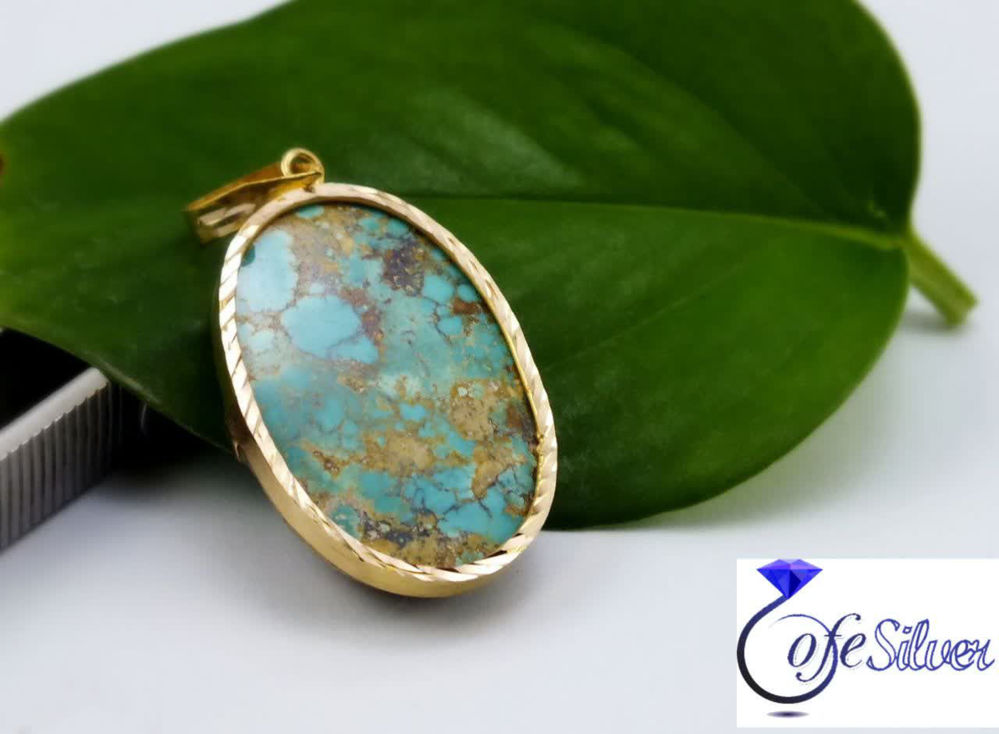
Cut turquoise stone
The time and energy required to process raw stones to make them presentable adds little value. Raw turquoise stones, also known as rough stones, are stones that have been pulled directly from the earth in their most natural state. In its unprocessed state, it can be very difficult to judge the true value of a stone.
It must first be processed to display the stone in its best form. Raw Stones now have an added value of (1) points. Stones can be rolled and polished, machines can help create standard size cabochons for mass-produced jewelry (2) points. The stones can either be machined into a cabochon shape (3) or it can be cut by hand to form a taxi (4) points. Finally, the stones can be sculpted by an artist (5) points.
Turquoise available
The less available the stone, the more valuable it is. For example, turquoise can be plastic and easily produced. Mass production of plastic is not valuable and receives a score of (1) on the TQI scale. Reconstructed turquoise from gypsum is easily made and receives a (3) rating.
The most common indicator of the availability of a stone is the turquoise mine. Different mines produce different amounts of turquoise. In a mine we can find different grades, colors and patterns. This causes this scale to fluctuate from year to year based on the production and distribution of turquoise in the mine.
Common mines such as the Great Chinese Mine (6 points) and the Kingman Mine (12 points) produce a lot of turquoise. Some smaller or unusual mines are well known but not producing enough.
These mines are scored (13-17). Small rare mines like Lander Blue in Nevada are said to have produced only a handful of pieces. This makes turquoise very rare and the value of the stones increases dramatically.
This type of mine is called "hat mine" because the amount of turquoise that comes from the mine can fit in a miner's hat (18-19) points. Also, rare samples from each of the mines are also included in this category (18-19) points. Finally, turquoise grows in other ways such as fossilized organic remains.
Fossil turquoise and petrified wood turquoise are good examples. It is very rare and receives a score of (20).
Color
Turquoise color is one of the most controversial signs of a stone's value. The ancient Iranians said that the blue color of the robin's egg is the most valuable. Some modern collectors say green colors are more valuable. Regardless of color, clarity is an important indicator of a stone's value. Rarity, consistency, and color contrast are more important factors because color preference is highly subjective. This means that color is not judged as much as its purity and clarity.
Artificial Turquoise is always one (1) point because the color can be controlled, this includes artificially restored turquoise.
Synthetic dyed stones were given a score of one (2) depending on the consistency of the color. Natural stones with very dull, dull, or rubbery colors with rough transitions between color shades and matrix receive a score of (3-5). It should be noted that the cloud is not like white or lighter shades of blue, but more of a pale or grainy natural color. Natural stones that are limited in true color expression and may have grainy transparency (6-7). Stones with darker colors, sharp clarity, and rich colors that may be slightly inconsistent (8-9). Finally, rich and consistent natural colors with consistent resolution (10) score.
Matrix pattern
This pattern is also a controversial indication of the value of the stone. In Iran, pure turquoise stone without any matrix is the most valuable. American contrast collectors feel that the variety of cobweb matrix patterns is the most valuable. Clarity means being clear or having good contrast. The less cloudy, cloudy, and cloudy the stone, the more valuable it is. Rarity is the focus of the TQI scale.
Artificial Turquoise is always a (1). Reconstructed turquoise engineered patterns (2-3) depending on complexity. Scattered matrix without apparent pattern (4-5) points. The matrix is compatible with the quantitative pattern or rare patterns (6-7).
Rare patterns such as cobweb, face stone, calico or turquoise receive pure matrixless (8-9). Finally, natural stones with exaggerated rare patterns receive a score of (10). It should be noted that turquoise without a pure matrix cannot be overstated.
It's the size that matters
It is a simple quality that is easy to measure and understand. Even though a very large piece of turquoise may be the size of several small pieces, it is usually worth a little more per carat.
This is because large interconnected pieces are harder to find in nature than small pieces. Again, it's a very small factor and usually doesn't make a significant change in price. A piece smaller than ¼ inch at its widest point receives (1) points. Points between ¼ inch and 1 inch (2), 1 inch to 2 inches (3), 2 inches to 4 inches (4). Finally, any stone greater than 4 inches at its widest measurable point (5).
Turquoise value TQI price per carat
Once you've evaluated your turquoise and have a total TQI score, compare it to the chart below to get the price per carat.
The price of turquoise stone
